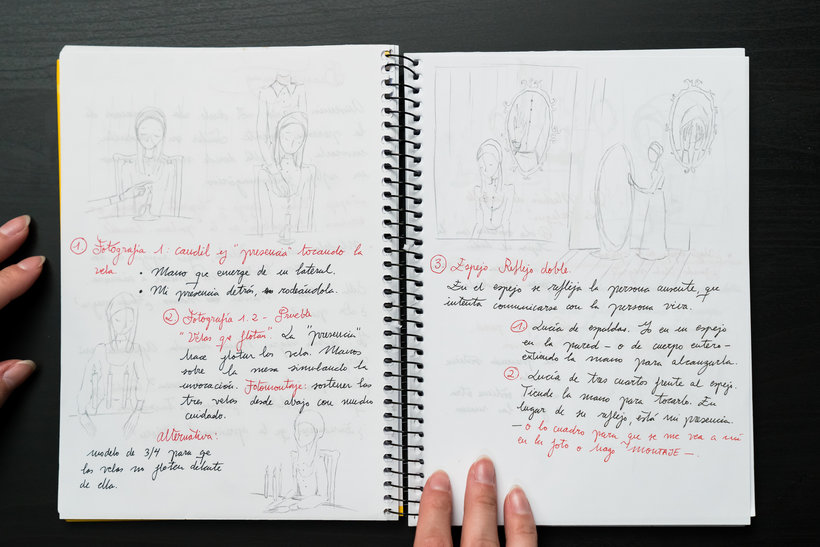Before the picture: the idea
Before starting our narrative photographic project, it is essential to know what we want to tell. As our project will consist of a series of photos, the idea must be powerful enough to be able to be developed through several images. In these lessons I will give you resources to stimulate the imagination and translate the abstract ideas into a narrative concept that we can visually develop through our images.
-
Narrating through photography: the photographic series
In this lesson I will explain what a narrative photograph is and how we can interpret it both by itself and within the set of a series of more images. I will also tell you what I was trying to convey with each of these series and how I used different narrative elements to achieve it.
-
Artist's Notebook
When developing our photographic series it is essential that we know what we want to narrate. It is important to have a notebook —or a blog, a tumblr… - in which to write down what inspires us, or to take notes that will later serve to shape our photographs. In this lesson I will tell you about my artist notebooks, what I collect in them and how many times these notes, ideas or images can inspire my photographs.
-
Visual culture
In this lesson I will tell you about the artists that are part of my visual culture. Having a broad visual culture will help and inspire us to bring our own creations to life.
-
The idea: brainstorming and sketches
There are infinite ways to develop ideas — taking other artists as a reference, writing thoughts, inquiring into our emotions, our experiences or our environment, etc. — but in my case, it is the brainstorm (or brainstorming ) the one that allows my inspiration to flow. In this lesson I will show you that secret notebook where my brainstorms roar, and how my photographs spring from this rain of words and concepts.
-
The photographic equipment
In this lesson I will tell you about the tools that I usually use to work when it is time to do the session. I will also give you some tips to take powerful and quality photographs without having to have a great photographic equipment.
Tasks
-
Start shaping your ideas Practice exercise 2.1
Take your notebook and let your imagination flow. Ask yourself what you want to narrate, why you want to do it, what elements you need to express what you want to express, etc., and tell it to the pages of your notebook. Then look at all those words and let the thought take you somewhere. I am sure that soon you will have a powerful idea to develop in your photographs.

-
Building the images: previous steps Practice exercise 2.2
Make sketches - it doesn't matter that you don't know how to draw! - of each of the images you want to build. Since we are working on an idea through several images, you will have to make several different sketches with each other (but related) and then be able to take several different photographs during the session. I encourage you to try without fear and to draw everything you can think of, even if in the end you do not get to transfer it to a photograph. Sometimes the sketches lead us to different images that we had not planned.
Additional resources
-
Narrative series
Here are the three complete narrative series that I talked about in the first lesson:
• Your branches / My bones
• A Child i Playing
• Inside the Dream -
Art Webs
I share a list of 20 websites and art magazines online where you can discover wonderful works by other artists:
• LensCulture
• Beautiful Bizarre
• Foam Magazine
• Artsy
• Booooooom
• Ithosmag
• Revista Détour
• FuckYeahArt
• Lamono Magazine
• If you leave
• worbz
• SHOTS Magazine
• IGNANT
• Portbox
• ORCHID Magazine
• Feature Shoot
• Sixteen Journal
• PHMuseum
• Femgrafía
• Art Deeva
Additional resources
-
PDF
Narrative photographic series: a comparison
In this resource I make a comparison of five different photographic narrative series that address the same topic: childhood. I will show you how different narrative resources can lead to very different series, even if they talk about the same thing.
-
PDF
Ways to feed the imagination
In this resource I am going to go beyond the brainstorming that I talked about in the lesson to offer you other alternatives so that you can get inspired and feed your imagination.



